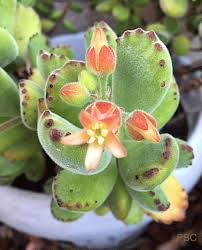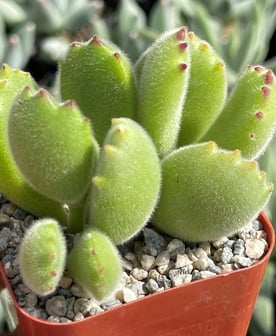
Plant of the week: Bear Paws
Meet Bear Paws (Cotyledon tomentosa), the succulent that’s as cute as it sounds. With its fuzzy, paw-shaped leaves, it’s like a teddy bear decided to become a plant. Perfect for forgetful waterers, this low-maintenance buddy thrives on neglect. Warning: its irresistible charm may lead to excessive cooing and nicknames like “Mr. Fluffypaws.”
PLANTS
Grace Chen
12/30/20243 min read


If you’re a fan of quirky, low-maintenance plants, Bear Paws (Cotyledon tomentosa) is a must-have for your collection. With its chubby, fuzzy leaves that resemble tiny bear paws, this succulent is as charming as it is easy to care for. Native to South Africa, Bear Paws brings a touch of whimsy and texture to any space. Here’s everything you need to know to keep this little gem thriving.
Growing Methods
Bear Paws thrive in conditions that mimic their native arid environment. Follow these tips to give your plant the best start:
Light requirements:
Bear Paws love bright, indirect light. A south- or east-facing window is ideal. They can tolerate some direct sunlight, but too much can scorch their delicate leaves. If the leaves start to turn red or brown, it’s a sign they’re getting too much sun.Soil:
Use a well-draining succulent or cactus mix. You can also make your own blend by combining potting soil with sand, perlite, or pumice. Good drainage is crucial to prevent root rot.Watering:
Water sparingly! Bear Paws are drought-tolerant and prefer to dry out completely between waterings. Overwatering is their kryptonite—soggy soil can lead to root rot. In winter, reduce watering even further as the plant goes dormant.Temperature and humidity:
Bear Paws prefer warm, dry conditions (60°F–75°F). They’re not fans of high humidity, so avoid placing them in steamy bathrooms. Protect them from frost, as they’re not cold-hardy.Propagation:
Propagate Bear Paws through stem or leaf cuttings. Let the cuttings callous over for a few days before planting them in well-draining soil. Be patient—succulents take time to root!
Maintenance Tips
Keeping your Bear Paws happy is a breeze with these simple care tips:
Pruning: Trim any dead or damaged leaves to keep the plant looking tidy. You can also prune to control its size or shape.
Fertilizing: Feed sparingly with a diluted succulent fertilizer during the growing season (spring and summer). Avoid fertilizing in winter when the plant is dormant.
Cleaning: Gently brush off dust from the fuzzy leaves with a soft brush or cloth. Avoid getting the leaves too wet, as they can rot.
Pests: Watch out for common succulent pests like mealybugs and spider mites. Treat infestations with neem oil or insecticidal soap.
Interesting Facts
Fuzzy defense: The tiny hairs on Bear Paws’ leaves, called trichomes, help protect the plant from harsh sunlight and reduce water loss—perfect for surviving in arid climates.
Seasonal blooms: In late winter or spring, mature Bear Paws may produce bell-shaped, orange-red flowers on tall stalks. It’s a rare but rewarding sight!
Toxic traits: Like many succulents, Bear Paws are toxic to pets and humans if ingested. Keep them out of reach of curious cats, dogs, and kids.
Slow grower: Bear Paws grow slowly, making them perfect for small spaces or as part of a succulent arrangement.
Nickname worthy: With their paw-like appearance, it’s no wonder this plant has earned adorable nicknames like “Bear’s Claw” or “Kitten Paws.”
Final Thoughts
Bear Paws (Cotyledon tomentosa) is the perfect plant for anyone who loves succulents with personality. Its unique texture, low-maintenance nature, and occasional blooms make it a standout addition to any plant collection. Whether you’re a seasoned succulent enthusiast or a beginner, this fuzzy little plant is sure to bring a smile to your face. Just remember: less water, more love!




